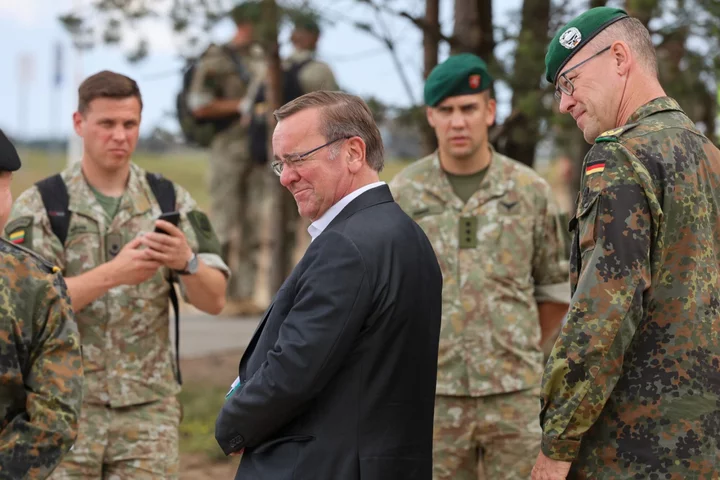Sign up to receive the Balance of Power newsletter in your inbox, and follow Bloomberg Politics on Twitter and Facebook for more.
Germany is preparing to station a permanent brigade of about 4,000 troops in Lithuania as NATO reassesses the potential threat Russia poses to the alliance’s eastern flank.
German Defense Minister Boris Pistorius made the announcement during a NATO training exercise in Lithuania on Monday. It followed months of pressure from Lithuanian officials, who have lobbied for a stronger stance to prevent Russian aggression. Germany had earlier planned on stationing troops in its own territory and rotating them to the Baltic country.
The move would add to a wider revamp of the North Atlantic Treaty Alliance’s defense posture in the east, and reflects Baltic concerns that Moscow may try to claw back the territory Estonia, Lithuania and Latvia regained after the collapse of the Soviet Union. Lithuania is particularly vulnerable, wedged between the Russian exclave of Kaliningrad and Belarus, which has agreed to station Russian tactical nuclear weapons on its territory.
“This will be a considerable effort,” Pistorius told reporters alongside his Lithuanian counterpart, Arvydas Anusauskas. “That’s why we’ve agreed to build up a brigade step by step.”
The uncertainty over Russia following the mutiny by mercenary leader Yevgeny Prigozhin against Vladimir Putin’s military leadership added a sense of urgency. Lithuanian President Gitanas Nauseda said the fallout, including Wagner units potentially moving into neighboring Belarus, impacted the region’s security. Pistorius said the situation in Russia “seems to be very unstable.”
Lithuania will also invest €240 million ($262 million) in military infrastructure and mobility through 2025 to accommodate the brigade.
NATO Overhaul
Pistorius and senior NATO officials are visiting Lithuania to watch Germany’s Griffin Storm exercise, which took place at a training ground about 20 kilometers (12.4 miles) from the border with Belarus and simulates an attack from an enemy from the north. The maneuver was designed to reinforce Berlin’s pledge until now that it would rapidly deploy a full-fledged brigade to the Baltics in an emergency — a complex operation that would be alleviated by a permanent presence.
Read more: Putin Faces Historic Threat to Absolute Grip on Power in Russia
NATO leaders last summer agreed to a broad overhaul of the alliance’s defense posture. This pledge included plans to put around 300,000 troops at higher readiness and commitments to be able to scale up eight multinational battle groups of around 1,000 troops each on the eastern flank to brigade size, which can be as big as 5,500 troops.
And in a first since the end of the Cold War, the alliance’s leaders in July are set to agree to detailed regional plans that lay out how allies are expected to defend areas against an attack from Russia or from terrorists.
In the Griffin Storm exercise, which started June 21 and runs through July 7, around 1,000 soldiers and 320 vehicles traveled the roughly 1,200 kilometers from the northeastern city of Neubrandenburg to Pabrade by air, rail, road and sea in around three days.
Defense Mobility
With Russian forces still bogged down in Putin’s war in Ukraine, Moscow’s ability to launch a large-scale conventional attack will be limited for some time, with military officials estimating it will take between three and five years for Russia to reconstitute its ground forces after the war.
As a result, some officials might conclude the rotational brigades would give them sufficient time to prepare against a possible assault, said Heinrich Brauss, a senior associate fellow at the German Council on Foreign Relations and NATO’s former assistant secretary general for defense policy from 2013 to 2018.
Read more: Russia Latest: NATO Chief Says Mutiny Reflects Putin’s Mistake
“For this whole defense posture based to a large degree on rapid reinforcement, the key challenge is military mobility,” Brauss said. That means ensuring everything is in place and will work smoothly in a crisis — from bridges that can carry the weight of heavy tanks to legal conditions to cross allied nations with military convoys.
“That is one of the reasons why the Baltic States and Poland are right in insisting to have already strong forces, forward deployed on a persistent basis,” he said. Brauss added that in a scenario where hostilities broke out, Russia could prevent reinforcements to the Baltics via the so-called Suwalki Gap, the stretch of land between Kaliningrad and Belarus.
A new NATO alert system, fed with intelligence from allies, will be designed to help speed up decisions to deploy forces before conflict breaks out. In the German brigade exercise, hostilities haven’t yet erupted in the scenario, allowing a small contingent to march by road through Poland and the Suwalki Gap into Lithuania.
While deploying the brigade quickly is important, it’s also critical that the mission goes smoothly and integrates into tactical plans, according to Brigadier General Christian Nawrat, the commander of the 41st Panzer Grenadier Brigade.
“Being here within two days but I don’t have a stack of material or personnel is not very helpful,” he said.
--With assistance from Milda Seputyte.

